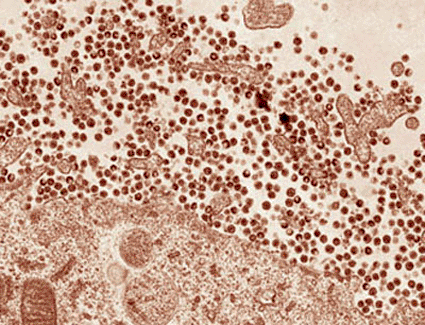Ebolavirus and HIV Share Common Mechanism for Inhibiting Antiviral Protein
By LabMedica International staff writers
Posted on 10 Feb 2009
Virologists have found that the cell surface protein tetherin, which has previously been shown to inhibit the spread of the AIDS virus, prevents release of Ebolavirus particles from host cells until neutralized by a protein expressed by the virus.Posted on 10 Feb 2009
The protein tetherin, also known as Bst-2 or CD317, is a recently identified, interferon-induced cellular response factor that blocks release of human immunodeficiency virus- (HIV)-1 and other retroviruses from infected cells. The means by which tetherin retains retroviruses on the cell surface, as well as the mechanism used by the HIV-1 accessory protein Vpu to block tetherin function and promote HIV-1 release, are unknown.

Image: HIV-1 particles (dark circles) lacking Vpu are unable to release themselves from the surface of their host cell, as tetherin keeps them glued to the surface of the cell’s outer membrane, or causes them to be sucked back in and digested within the cell (Photo courtesy of Rockefeller University).
In the current study, investigators at the University of Pennsylvania School of Medicine (Philadelphia, USA) extended their research on tetherin to a different class of virus, the filovirus Ebola. Filoviruses have an unusual morphology, with the virus particle appearing as long thin rods. A filovirus is composed of a single species of ribonucleic acid (RNA) molecule that is bound together with special viral proteins. A membrane derived from the outer membrane of infected cells surrounds this RNA-protein complex. Infectious viruses are formed when the virus buds from the surface of infected cells and is released. Spiked structures on the surface of the virus particles serve to recognize and attach to specific receptor molecules on the surface of susceptible cells, allowing the virus to penetrate the cell. The genetic information contained in the RNA molecule directs production of new virus particles by using the cellular machinery to drive synthesis of new viral proteins and RNA.
Results published in the January 28, 2008, online edition of the journal the Proceedings of the [U.S.] National Academy of Sciences (PNAS) revealed that Ebola, like HIV, has evolved a mechanism for neutralizing tetherin, whose function is to prevent the release of newly formed virus particles. Expression of the Ebola glycoprotein (GP) reversed the antiviral effect of human and mouse tetherin and facilitated budding of Ebola particles. When added to cell cultures, isolated HIV-1 Vpu protein also promoted Ebola release. Conversely, Ebola GP could substitute for Vpu to promote release of HIV-1 from tetherin-expressing cells, demonstrating a common cellular target for these divergent viral proteins.
"This information gives us a new way to study how tetherin works," said senior author Dr. Paul Bates, associate professor of microbiology at the University of Pennsylvania School of Medicine. "Binding of a protein produced by Ebola to tetherin apparently inactivates this cellular factor. Understanding how the Ebola protein blocks the activity of tetherin may facilitate the design of therapeutics to inhibit this interaction, allowing the cell's natural defense systems to slow down viral replication and give the animal or person a chance to mount an effective antiviral response and recover."
"Tetherin represents a new class of cellular factors that possess a very different means of inhibiting viral replication," said Dr. Bates. "Tetherin is the first example of a protein that affects the virus replication cycle after the virus is fully made and prevents the virus from being able to go off and infect the next cell. Because we see such broad classes of viruses that are affected by tetherin, it is possible that all enveloped viruses are targets of this antiviral system. If so, then understanding how tetherin works and how viruses escape from the effect of tetherin will be very important."
Related Links:
University of Pennsylvania School of Medicine













